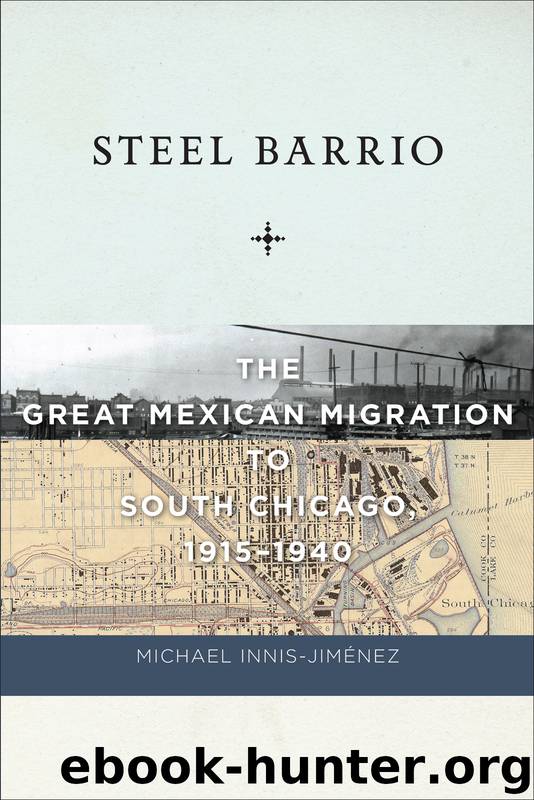Steel Barrio by Michael Innis-JiméNez

Author:Michael Innis-JiméNez
Language: eng
Format: epub
Publisher: New York University Press
Published: 2013-03-11T16:00:00+00:00
Fig. 6.1. Alfredo de Avila’s naturalization card. Note the handwritten “Communist Investigation” note. It was not uncommon for union activists to be suspected communists. His naturalization is during World War II, a time when many Mexicans in the steel industry were pressured to become citizens. Soundex Index to Naturalization Petitions for the United States District and Circuit Courts, Northern District of Illinois and Immigration and Naturalization Service District 9, 1840–1950. National Archives and Records Administration, Washington, DC. Microfilm: M1285 Roll 40.
Cultural celebrations also provided Mexicans and their mutualistas a way to resist the ever-present harassment and to aid in the creation of Mexican-friendly physical and cultural environments. Mexican cultural ideals brought to and developed in South Chicago were yet another iteration of “Mexican culture” and distinct from other Mexican communities in the United States. Members of the community embraced Mexican cultural celebrations and practices promoted by the mutualistas, the Mexican consul, and other local patriotic organizations. This pushed Mexicans to look inward in defense of their cultural practices and celebrations as functions of their fundamental ideals in the face of a constant pressure to Americanize. In assimilating only to the extent necessary to survive and improve their quality of life, Mexican Chicagoans created an idealized Mexican culture distinct to Chicago, one reinforced by the Mexican state through the local consul.
On the other hand, too much public celebrating had drawbacks regardless of the “third-space” celebrations occupied. Worried that Mexicans would be seen as bad, lazy workers, the Correo Mexicano newspaper urged its readers to go back to work immediately after the September 16th Mexican independence day celebrations in 1926. After members of the community had “complied with one of the most sacred duties of being Mexican” by honoring “the men of the patria, the heroes that offered their lives so that we may have ours,” it was time to get back to work, “to follow the trail blazed by the books, by the moralists and by the teachers of the secondary schools and universities.”74 On top of revealing the fears of middle-class Mexicans about how outsiders would perceive the community if members of the working-class took too much time to celebrate, this editorial is significant because it provides a glimpse of the scale in which members of the community participated in the celebrations. More than a light-hearted fun time, participation in the celebrations was a “sacred” duty. The Correo thus espoused the tenets of a civic religion centered on the Mexican state and those who had created it. First among those honored were, of course, the warrior “heroes” who had died for the patria and thus enabled the immigrants’ lives in 1926. Mexicans’ next responsibility, however, was to honor the work of writers, philosophers, teachers, and professors who had defined the path to the creation of a nation. The editorial drove home the point that the Correo’s readers might best continue these intellectuals’ legacy by following their trail back to work—that is, to labor that was not so incidentally quite far afield from those who “blazed” the trail.
Download
This site does not store any files on its server. We only index and link to content provided by other sites. Please contact the content providers to delete copyright contents if any and email us, we'll remove relevant links or contents immediately.
| General | Discrimination & Racism |
Nudge - Improving Decisions about Health, Wealth, and Happiness by Thaler Sunstein(7615)
iGen by Jean M. Twenge(5366)
The Fire Next Time by James Baldwin(5249)
Adulting by Kelly Williams Brown(4487)
The Hacking of the American Mind by Robert H. Lustig(4318)
The Sports Rules Book by Human Kinetics(4294)
The Ethical Slut by Janet W. Hardy(4173)
Captivate by Vanessa Van Edwards(3796)
Mummy Knew by Lisa James(3634)
In a Sunburned Country by Bill Bryson(3485)
The Worm at the Core by Sheldon Solomon(3435)
Ants Among Elephants by Sujatha Gidla(3417)
The 48 laws of power by Robert Greene & Joost Elffers(3024)
Suicide: A Study in Sociology by Emile Durkheim(2973)
The Slow Fix: Solve Problems, Work Smarter, and Live Better In a World Addicted to Speed by Carl Honore(2947)
Humans of New York by Brandon Stanton(2835)
The Tipping Point by Malcolm Gladwell(2827)
Handbook of Forensic Sociology and Psychology by Stephen J. Morewitz & Mark L. Goldstein(2658)
The Happy Hooker by Xaviera Hollander(2655)
